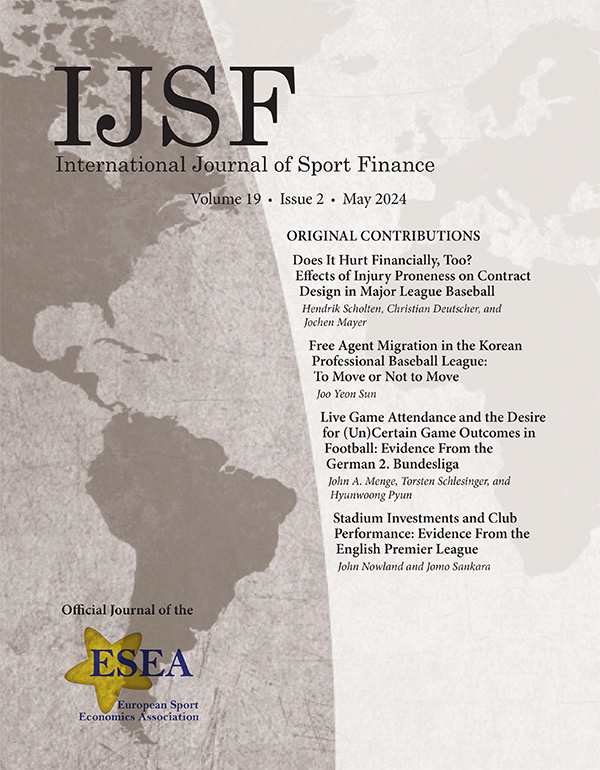
Articles
Does It Hurt Financially, Too? Effects of Injury Proneness on Contract Design in Major League Baseball
This paper seeks to determine the financial costs of recent injuries and market expectations of players’ future attrition rates by investigating the impacts on free agent contract designs, as represented by the yearly salary and contract length. The empirical findings, derived from data about 698 free agent contracts in Major League Baseball between 2011 and 2018, indicate that injuries exert different impacts on salaries versus contract lengths. For example, free agents who recently injured an elbow or shoulder receive shorter contracts than those not injured in the previous season, but their salaries are not affected. Market expectations of player attrition in the upcoming season reduce both contract lengths and salaries. For players, these results reaffirm the importance of staying healthy and finding ways to signal the low likelihood of future injuries to ensure their remuneration. For managers, the results emphasize the need to track free agents’ health status carefully, especially to avoid a winner’s curse.
Keywords: injuries, salary, contract length, contract design, Major League Baseball
DOI: doi.org/10.32731/IJSF/192.052024.01
Free Agent Migration in the Korean Professional Baseball League: To Move or Not to Move
This study explores free agent transactions of the Korea Baseball Organization from 2000 to 2018. It examines whether player mobility patterns differ across free agent pitchers and hitters. The probability of free agent pitchers transferring increases with the pitching position of the starting or closer pitcher. The probability of transfer for a hitter is negatively associated with age and left-handedness. The inertia of staying with the current team increases when substantial signing bonuses are paid to the free agent pitcher. A strong contract year affects the hitter mobility model, with a higher probability of transfer and a greater contribution to team wins in the final year before free agency. The longer a free agent’s contract, the higher the probability of them moving. A huge increase in the annual salary one year before free agent eligibility hinders the movement of hitters, whereas financial compensation does not constrain pitchers’ move.
Keywords: player mobility, performance, free agency, contract year, professional baseball
DOI: doi.org/10.32731/IJSF/192.052024.02
Live Game Attendance and the Desire for (Un)certain Game Outcomes in Football: Evidence From the German 2. Bundesliga
This study aims to analyze fans’ demand for live football matches in the German 2. Bundesliga, focusing on match-outcome uncertainty. To examine the decision to attend sporting events, a fixed effects regression and the Tobit model were used to test the uncertainty of game outcomes and reference-dependent preferences with loss aversion. The estimated fans’ demand for attending live football matches is represented by the logged attendance of 2,442 matches from the 2010/2011 to the 2017/2018 seasons of the 2. Bundesliga. Our findings indicate that fans prefer certain game outcomes over uncertain ones. In other words, reference-dependent preferences with loss aversion dominate the desire for close competition. We estimated our main model using various proxies of uncertainty as robustness checks, and the results confirmed our findings.
Keywords: uncertainty of outcome hypothesis, reference-dependent preferences, loss aversion, competitive balance, football, soccer
JEL: L83, D12, Z20
DOI: doi.org/10.32731/IJSF/192.052024.03
Stadium Investments and Club Performance: Evidence From the English Premier League
Many professional football clubs have big plans for new stadiums or stadium expansions. Bigger stadiums are a sign of status, help to increase and diversify revenue streams, and enhance the fan experience. So how should a football club go about getting a bigger stadium? Should they build a new one or expand their existing stadium? And how are these stadium investments associated with club performance? Using an event study approach, we analyze sporting performance in the years around stadium investments in the English Premier League from 1992/1993 to 2021/2022. We find that clubs with stadium expansions have better subsequent sporting performance while clubs with new stadiums do not. Further analysis indicates that investments in new stadiums are associated with a temporary decrease in transfer expenditure. This decrease is not the case for stadium expansions as transfer expenditure is maintained and performance on the field subsequently improves. In summary, our analysis indicates that stadium expansions are the better option for professional football clubs as they increase both stadium capacity and sporting performance in the short-term.
Keywords: investment, performance, new stadiums, stadium expansions, football
DOI: doi.org/10.32731/IJSF/192.052024.04

